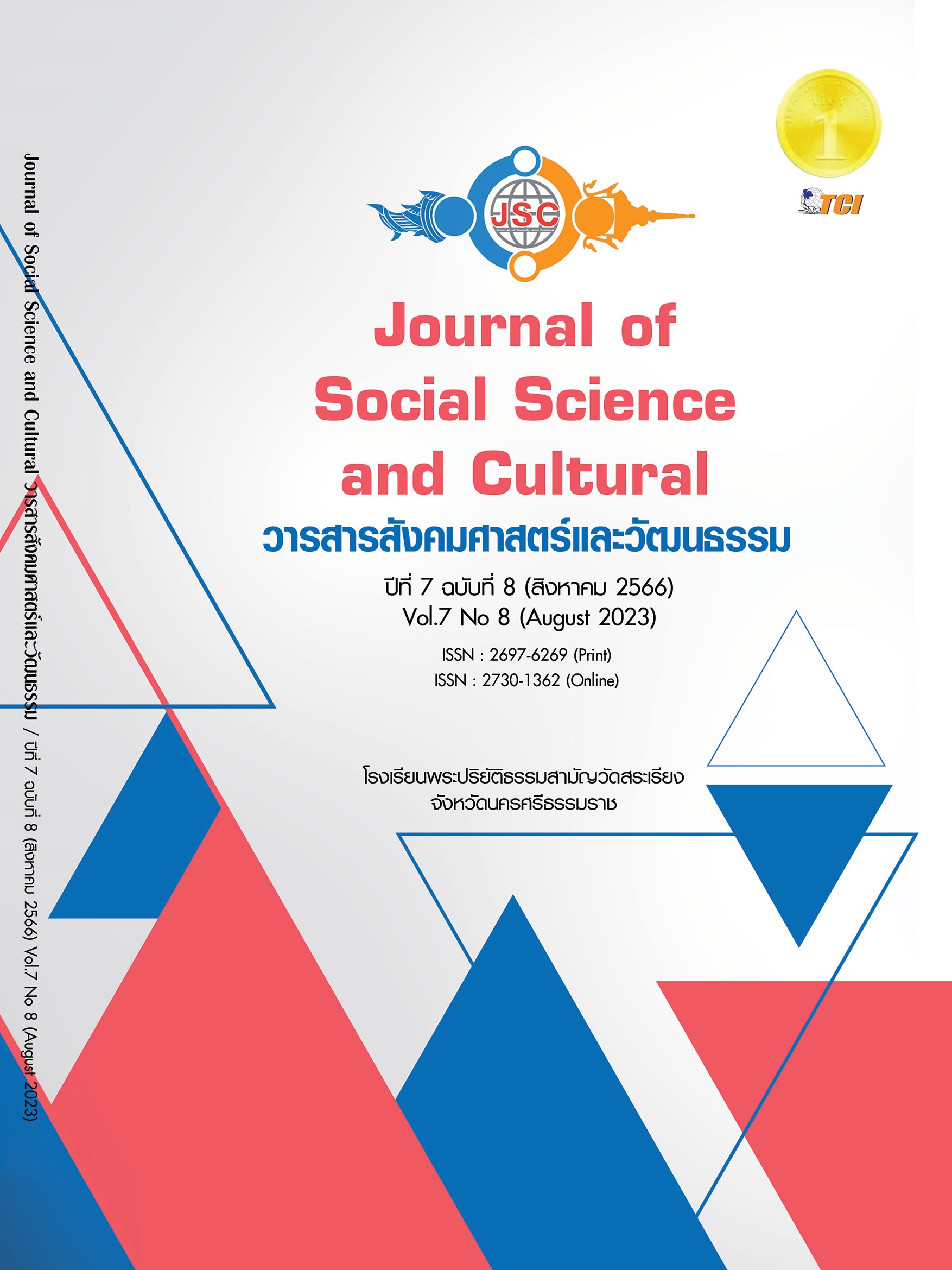ACTIVITY PACKAGE TO CREATE VALUE APPRECIATION OF COMMUNITY ART FOR YOUTH: CASE STUDY OF LAMPANG GOLD LEAF LACQUER DECORATIONS
Main Article Content
Abstract
This research aimed to explore the fundamental principles behind the design of an activity set aimed at promoting the appreciation of community arts among the youth: A Case Study of Lampang Gold Leaf Lacquer. This research is Research and Development by employing Bloom (et al.) taxonomies of learning objectives, focusing on the Cognitive Domain and Psychomotor Domain, along with the Theory of Arts Education emphasizing Thai wisdom, Principles of Organizing Community Art Activities, and insights from expert Interviews. This sample group consists: 1) Community artists, 2) Experts in Thai Art, 3) Experts in Art History, 4) Teachers, 5) Community art activity organizers, totaling 15 participants by using data collection tools as data collection through interviews to gather historical background and the relationship between artwork and the community. The data was then analyzed using content analysis. The findings from the document study and expert interviews could be summarized as research results in a series of activity sets aimed at promoting the appreciation of community arts among youth. The activity set comprised 5 aspects, including 1) Content, 2) Technical, 3) Activity formats, 4) Participation, 5) Dissemination. The activity set was divided into 4 activities, including 1) Community Learning , Exploring Local Artistic Works, 2) 4 Techniques : Lai Kham Artwork 3) Collaborative Creativity Activity: Creating Contemporary. 4) Local Art in Lampang Exhibition. The data collection tools for evaluating the usage of the activity set consists 1) Test questionnaire to assess participants' understanding of the knowledge related to Lampang Craftsmenship artwork "Lai Kham". 2) Measurement form of participants' attitudes toward the significance. 3) Measurement form to measure individual perceptions of the value derived from observing an individual's behavior. 4)Assessment form to determine satisfaction levels regarding the format of the activity set. The evaluation IOC from qualified found that such a set of activities had a consistency of 0.8 levels.
Article Details
References
ณัฐกาญจน์ จันทน์เนื้อไม้. (2561). การพัฒนาชุดกิจกรรมการเรียนรู้เพื่อส่งเสริมการเห็นคุณค่าศิลปะล้านนา. ใน วิทยานิพนธ์ครุศาสตรมหาบัณฑิต สาขาวิชาศิลปศึกษา. จุฬาลงกรณ์มหาวิทยาลัย.
ทิศนา แขมมณี. (2562). ศาสตร์การสอน. กรุงเทพมหานคร: โรงพิมพ์แห่งจุฬาลงกรณ์มหาวิทยาลัย.
ธีติ พฤกษ์อุดม. (2560). การพัฒนากิจกรรมศิลปะเพื่อส่งเสริมการเห็นคุณค่าของอัตลักษณ์ในงานศิลปหัตถกรรมภาคใต้สำหรับเยาวชน. ใน วิทยานิพนธ์ครุศาสตรมหาบัณฑิต สาขาวิชาศิลปศึกษา. จุฬาลงกรณ์มหาวิทยาลัย.
เนื้ออ่อน ขรัวทองเขียว. (2556). ความเข้าใจในงานจิตรกรรมไทยประเพณี. กรุงเทพมหานคร: โรงพิมพ์แห่งจุฬาลงกรณ์มหาวิทยาลัย.
ปุณณรัตน์ พิชญไพบูลย์. (2561). จิตวิทยาศิลปะ: สุนทรียศาสตร์เชิงประจักษ์. กรุงเทพมหานคร: โรงพิมพ์แห่งจุฬาลงกรณ์มหาวิทยาลัย.
พระราชบัญญัติส่งเสริมและรักษามรดกภูมิปัญญาทางวัฒนธรรม พ.ศ.2559. (2563). ราชกิจจานุเบกษา เล่ม 133 ตอนที่ 19 ก หน้า 1 (7 มีนาคม 2563).
เพ็ญสุภา สุคตะ. (2563). ภาพบานประตูก่อนบูรณะ อนุสรณ์ต่างหน้าชิ้นสุดท้าย ของ “วิหารวัดหมื่นล้าน”. เรียกใช้เมื่อ 31 กรกฎาคม 2563 จาก https://www.matichonweekly.com/column/article _333130
ลิปิกร มาแก้ว. (2558). ลายคำน้ำแต้ม. เชียงใหม่: โฮงเฮียนสืบสานภูมิปัญญาล้านนา.
วิรุณ ตั้งเจริญ. (2548). ทัศนศิลปศึกษา. กรุงเทพมหานคร: สันติศิริการพิมพ์.
สำนักนายกรัฐมนตรี สำนักงานคณะกรรมการการศึกษาแห่งชาติ. (2545). รายงานการประชุมทางวิชาการเรื่องทิศทางวัฒนธรรมกับการศึกษาในกระแสแห่งการเปลี่ยนแปลง. กรุงเทพมหานคร: ห้างหุ้นส่วนจำกัด วี.ที.ซี.คอมมิวนิเคชั่น.
สุรพล ดำริห์กุล. (2564). ลายคำล้านนา. กรุงเทพมหานคร: สำนักพิมพ์เมืองโบราณ.
สุวิภา จำปาวัลย์ และชัปนะ ปิ่นเงิน. (2553). การศึกษาพุทธสัญลักษณ์ล้านนา. เชียงใหม่: สถาบันวิจัยสังคมมหาวิทยาลัยเชียงใหม่.
อภิชาติ พลประเสริฐ และสริตา เจือศรีกุล. (2561). ผลการจัดกิจกรรมศิลปะเพื่อชุมชนในมหกรรมรองเมืองเรืองยิ้ม. วารสารศิลปกรรมศาสตร์ มหาวิทยาลัยศรีนครินทรวิโรฒ, 22(1), 86-98.


